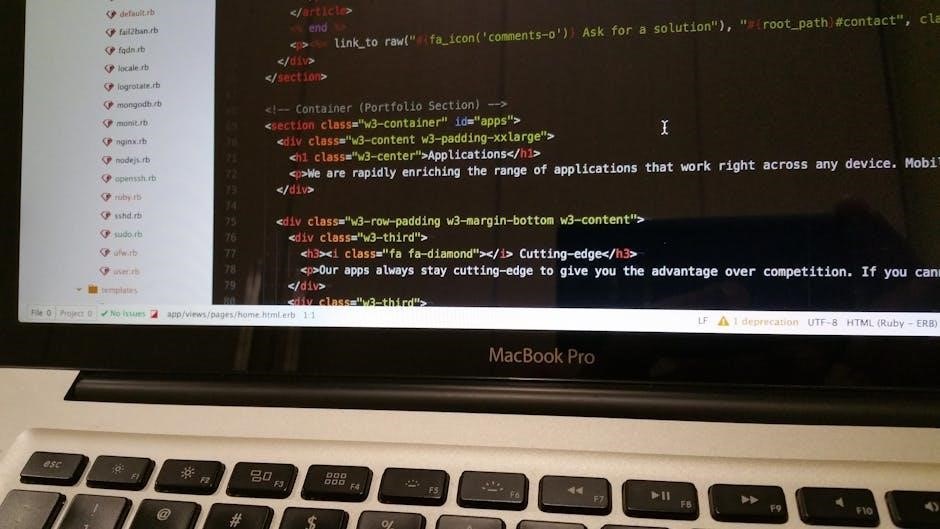Discover the essential HTML and CSS books in PDF format, offering comprehensive guides for mastering web development. Explore core concepts and practical examples to build stunning websites effectively.
Overview of HTML and CSS
HTML (Hypertext Markup Language) and CSS (Cascading Style Sheets) are the backbone of web development. HTML structures content, while CSS styles it, creating visually appealing and responsive websites. Together, they enable developers to build dynamic, user-friendly web pages. Books on HTML and CSS provide in-depth guidance, from basic syntax to advanced techniques, helping learners master these essential tools for modern web design and development.
Why Learning HTML and CSS is Important
Mastering HTML and CSS is crucial for building a strong foundation in web development. These technologies enable the creation of structured, visually appealing, and functional websites. Understanding HTML and CSS is essential for any web professional, as they form the backbone of front-end development. Proficiency in these skills opens doors to career opportunities and serves as a stepping stone for learning advanced web technologies like JavaScript and frameworks.
Best Resources for Beginners
For those starting with web development, essential resources like HTML and CSS books in PDF format are indispensable. Titles such as HTML and CSS: Design and Build Websites by Jon Duckett and HTML5 and CSS3: The Good Parts by Ben Henick provide clear, practical guidance. These resources offer hands-on learning, visual examples, and comprehensive coverage of core concepts, making them ideal for building a strong foundation in web development and design.

Top HTML and CSS Books in PDF Format
Explore the most recommended HTML and CSS books in PDF format, offering in-depth guides for web development. These resources cover basics, advanced techniques, and practical examples for building modern websites.
HTML and CSS: Design and Build Websites by Jon Duckett
HTML and CSS: Design and Build Websites by Jon Duckett is a visually engaging guide that teaches web development fundamentals. It covers essential topics like structure, text, lists, links, images, tables, and layouts. With clear explanations and practical examples, this book helps beginners and intermediate learners create visually appealing, user-friendly websites. Duckett’s approach ensures a solid foundation for modern web design and development.
HTML5 and CSS3: The Good Parts by Ben Henick
HTML5 and CSS3: The Good Parts by Ben Henick is a concise and practical guide focused on modern web development. It highlights essential features of HTML5 and CSS3, emphasizing efficient coding practices. The book distills core concepts into clear, actionable advice, helping developers create clean, maintainable websites. Perfect for those seeking to master the fundamentals, it ensures a strong foundation in contemporary web design and development techniques.
CSS3 Succinctly: A Concise Guide to CSS3
CSS3 Succinctly: A Concise Guide to CSS3 is a straightforward and practical guide to mastering CSS3. It covers advanced features like selectors, flexbox, and responsive design, providing clear examples and real-world applications. This book is ideal for developers looking to enhance their skills with modern CSS techniques, ensuring efficient and effective web design without unnecessary complexity.
Understanding Flexbox: A Comprehensive Guide
Understanding Flexbox: A Comprehensive Guide is a detailed resource for mastering CSS Flexbox. It explores the fundamentals of flex containers, items, and properties, offering practical examples to create responsive layouts. The guide covers alignment, distribution, and ordering, making it essential for developers seeking to build modern, flexible web designs efficiently. This PDF resource is ideal for both beginners and experienced developers looking to refine their Flexbox skills.

Learning HTML and CSS Beyond Books
Explore online courses, tutorials, and practical projects to enhance your HTML and CSS skills. Join communities and forums for continuous learning and professional growth in web development.
Online Courses and Tutorials
Expand your skills with a variety of free and paid online courses and tutorials. Platforms like Codecademy, FreeCodeCamp, and W3Schools offer interactive lessons. These resources provide hands-on experience, covering everything from basic syntax to advanced techniques; Tutorials often include exercises and projects, allowing you to practice while learning. They complement PDF books by offering a more dynamic and engaging way to master HTML and CSS. Many courses are updated regularly to reflect modern standards and best practices.
Practical Projects to Enhance Skills
Engage in practical projects to apply your HTML and CSS knowledge. Start with simple tasks like building a personal website or a to-do list. Progress to more complex projects, such as cloning a website layout or creating a responsive portfolio. These exercises help reinforce concepts learned from PDF books and improve problem-solving skills. Hands-on experience is key to mastering web development and building confidence in your abilities.
Community and Forums for Support
Join online communities like Stack Overflow and Reddit for HTML and CSS support. Participate in forums such as CSS-Tricks and Mozilla Developer Network to troubleshoot issues and gain insights. Engage with developers, share projects, and learn from others. These platforms offer valuable resources, feedback, and updates on web development trends, helping you grow as a developer and stay connected with the global coding community.
Tools for HTML and CSS Development
Essential tools include Visual Studio Code, Sublime Text, and Chrome DevTools for coding and debugging. CSS Linters ensure clean code, while Browser Extensions enhance workflow efficiency.
Code Editors and IDEs
Popular code editors like Visual Studio Code and Sublime Text offer powerful features for HTML and CSS development. Atom and Brackets are also excellent choices, providing syntax highlighting and code completion. For more advanced needs, JetBrains IDEs offer robust tools. These editors enhance productivity with extensions, real-time previews, and built-in debugging, making it easier to write clean and efficient code for web development projects;
Browser Developer Tools
Browser developer tools are essential for debugging and optimizing HTML and CSS. Features like element inspection, real-time code editing, and performance analysis help identify issues quickly. Tools like Chrome DevTools, Firefox Developer Edition, and Safari Web Inspector provide comprehensive insights. They enable developers to test responsiveness, debug layouts, and improve site performance, making them indispensable for modern web development workflows and ensuring a seamless user experience.
Validation and Debugging Tools
Validation and debugging tools are crucial for ensuring error-free HTML and CSS code. The W3C Markup Validation Service checks HTML and CSS for compliance with standards. Tools like JSHint or JSLint help identify issues in JavaScript code. Online platforms such as CodePen and JSFiddle allow real-time testing and debugging. Additionally, CSSLint helps maintain clean and readable CSS stylesheets, ensuring cross-browser compatibility and optimal performance for web developers.

Best Practices for Writing HTML and CSS
Adopt best practices to ensure clean, maintainable code. Use semantic HTML tags, CSS variables, and responsive design techniques for consistency and cross-device compatibility.
Writing Clean and Maintainable Code
Writing clean and maintainable code is essential for efficient web development. Use semantic HTML tags to define content structure clearly. Organize CSS with methodologies like BEM for better readability. Add meaningful comments to explain complex logic. Regularly review and refactor code to eliminate redundancies. Ensure proper indentation and naming conventions for consistency. These practices enhance collaboration and simplify future updates, making your codebase robust and scalable.
Using CSS Variables Effectively
CSS variables enable efficient theming and customization by allowing values to be stored and reused across a project. Define variables for colors, spacing, and typography to streamline updates. Use `:root` for global variables and scope them with classes or elements for specificity. This approach reduces redundancy, enhances consistency, and simplifies maintenance. Organize variables in a dedicated section for clarity and adopt meaningful naming conventions for better readability and scalability.
Responsive Web Design Techniques
Responsive web design ensures websites adapt seamlessly to various screen sizes and devices. Key techniques include using Flexbox, CSS Grid, and media queries to create fluid layouts. Implementing a mobile-first approach, fluid typography, and the viewport meta tag enhances accessibility. Leverage percentage-based widths and scalable images to maintain consistency across devices. Organize styles with CSS variables for efficient updates and improved maintainability in modern web development practices.
Advanced Topics in HTML and CSS
Explore advanced techniques like CSS Grid, Flexbox, animations, and transitions to create complex, responsive designs. Optimize performance and enhance accessibility in modern web applications.
Mastering CSS Flexbox and Grid
CSS Flexbox and Grid are powerful layout systems for creating responsive designs. Flexbox excels at one-dimensional layouts, aligning items with precision, while Grid offers two-dimensional control, enabling complex, structured layouts. These tools simplify responsive design, improve workflow, and enhance maintainability. By mastering Flexbox and Grid, developers can build modern, adaptive web interfaces with ease, ensuring optimal user experiences across devices.
Advanced Selectors and Specificity
Mastering advanced CSS selectors and specificity is crucial for precise styling. Selectors like classes, IDs, attributes, and combinators enable targeting specific elements. Understanding specificity ensures your styles are applied correctly, avoiding conflicts. This expertise allows for cleaner, more maintainable code and enhances control over complex layouts, making it easier to achieve consistent and visually appealing designs across your web projects.
Optimizing Performance with CSS
Enhance website performance by leveraging CSS best practices. Utilize CSS variables for consistency and reduced redundancy. Optimize animations to minimize performance impact. Implement lazy loading for images and media. Prioritize mobile-first design to reduce unnecessary styles. Use pre-processors like Sass for cleaner code. Optimize the critical rendering path by inlining critical styles and deferring non-essential CSS. These techniques ensure faster load times and smoother user experiences.
Comparing Different Book Editions
Explore various editions of HTML and CSS books in PDF format, each offering unique insights and updated techniques for web development. Compare comprehensive guides, modern updates, and concise references to find the perfect fit for your learning journey.
HTML and CSS: The Complete Reference
This comprehensive guide, now in its fifth edition, provides an in-depth exploration of HTML and CSS, covering foundational principles, structure, text styling, and advanced layout techniques. Published by McGraw-Hill, it serves as an invaluable resource for both beginners and experienced developers, offering detailed explanations and practical examples to master modern web development. The book is widely regarded for its clear, organized approach to complex topics, making it a must-have for anyone aiming to build robust, responsive websites.
Head First HTML and CSS
Head First HTML and CSS is a visually engaging guide that simplifies web development basics. Designed for beginners, it uses a unique, conversational style with plenty of examples and exercises. The book covers essential HTML and CSS concepts, helping learners build functional and attractive websites. Its interactive approach makes complex topics accessible and fun, ensuring a solid foundation for further study.
HTML: The Definitive Guide
HTML: The Definitive Guide is a comprehensive resource for mastering HTML, providing in-depth coverage of both basic and advanced techniques. Published by O’Reilly Media, this book serves as a complete reference for developers, covering topics from structure to dynamic content. It is widely regarded as a go-to guide for building robust and standards-compliant web applications, making it essential for both beginners and experienced developers.

Importance of PDF Resources
PDF resources offer accessibility, convenience, and cost-effectiveness, enabling offline learning and reference. They provide a portable format for mastering HTML and CSS without internet dependency, making them invaluable for developers.
Accessibility and Convenience
PDF resources for HTML and CSS books offer unparalleled accessibility and convenience. They are easily downloadable, compatible with all devices, and allow offline access, making learning flexible. The portable format ensures that developers can study anytime, anywhere without internet dependency. Additionally, PDFs are often lightweight, enabling quick sharing and storage. Their structured layout and navigation features enhance readability, while zoom and search functions make content easily accessible for learners of all levels.
Offline Learning and Reference
PDF books provide the freedom to learn HTML and CSS without an internet connection. Users can access materials anytime, making them ideal for remote areas or travel. Offline resources allow for uninterrupted study and quick reference, enhancing productivity. The ability to save and revisit content ensures continuous learning, while features like search and bookmarks enable efficient navigation and review of key concepts, making PDF books indispensable for self-paced education.
Cost-Effective Learning
PDF books offer a budget-friendly way to master HTML and CSS. Many resources are free or low-cost, making quality education accessible to everyone. Eliminate shipping expenses and gain instant access to downloadable materials. These books provide long-term value, as they can be revisited and referenced repeatedly. Affordable learning options ensure that beginners and professionals alike can enhance their skills without financial strain, making PDF resources a smart investment for web development education.

Community Recommendations
Community recommendations highlight top-rated HTML and CSS PDF books, often praised for their clear explanations and practical examples, helping learners stay updated with the latest web development trends.
Popular Books Among Developers
Developers highly recommend books like HTML and CSS: Design and Build Websites by Jon Duckett and HTML5 and CSS3: The Good Parts by Ben Henick. These resources are praised for their comprehensive coverage of web development fundamentals, offering practical examples and clear explanations. They are ideal for both beginners and experienced developers, providing insights into modern techniques and best practices for creating responsive and visually appealing websites effectively.
Expert Opinions on Learning Resources
Experts highly recommend books like HTML and CSS: Design and Build Websites and HTML5 and CSS3: The Good Parts for their clear, practical guidance. These resources are praised for their structured approach, covering foundational to advanced topics. They emphasize real-world applications, making them ideal for developers aiming to master modern web development techniques effectively.
User Reviews and Ratings
Users praise HTML and CSS: Design and Build Websites for its visual approach, while HTML5 and CSS3: The Good Parts is lauded for its concise insights. Many reviewers highlight the clarity and practical examples in these books, with ratings often exceeding 4.5 stars. Beginners appreciate the step-by-step guidance, and experts commend the focus on modern techniques. These resources are consistently recommended for their accessibility and effectiveness in learning web development skills.


0 Comments